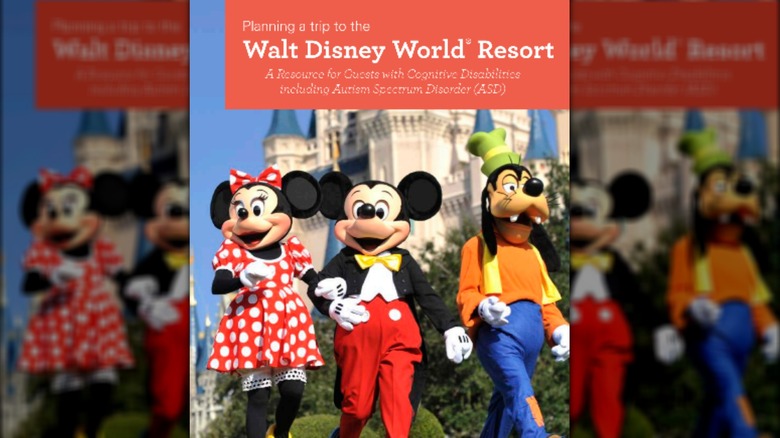Read Disney’s cognitive disabilities resource guide
The Walt Disney World Resort has developed a guide specifically designed to help guests with cognitive disabilities, including autism, maximize the comfort and quality of their Disney experience. The colorful, easy-to-use 38-page cognitive guide comes in a PDF you can check out on your home computer before you travel and download to your phone so that it can easily be accessed while you’re visiting the parks. Even though the Florida Disney park is its guide’s focus, much of the information it conveys could be easily applied to a trip to some of Disney’s other destinations.
The guide includes a list of frequently asked questions that cover things like choosing the best time to travel with sensory issues on deck and how to access resources like companion (family) bathrooms and wheelchair or stroller rental. It also covers how to use the Rider Switch, which allows parties of three or more to swap places in line if one member can’t ride. The guide even offers information on how to arrange meals for individuals with special dietary needs while you’re at the parks, something Disney does exceptionally well.
In the guide’s “What to Expect” section, you’ll find story pictures to help prepare for the adventure awaiting you or create a visual schedule. There’s also a list of suggestions to help your family prepare for the trip and a list of things you might consider packing to support your loved one — items like sensory toys, headphones, and an identification bracelet or nametag.
Choose your travel dates carefully
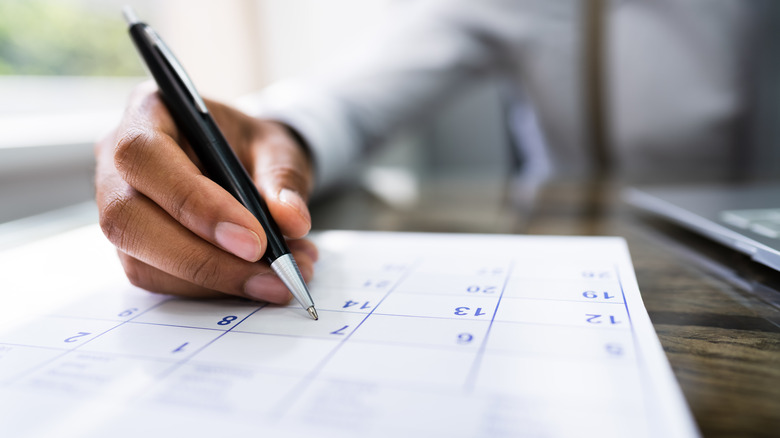
For neurospicy folks, crowds can be overwhelming — and not much will suck the fun out of a vacay faster than oppressive summer heat. Some folks can tolerate a little chaos up to a point when all of the sights, sounds, and smells get to be too much. When our son was younger, this meant he would be having an amazing time until all of that sensory input caught up with him, causing what’s known as a “meltdown” or a quieter but equally painful “shutdown.” So anything we can do to help minimize crowd density can dramatically alter our Disney trip.
I learned the value of carefully choosing our Disney travel dates as a kid while watching my mom painstakingly map out our travel dates based on historical crowd density and temperature from her vacation bible, Birnbaum’s Official Walt Disney World Guide Book. This usually meant traveling right before the Christmas crowd picks up. Not only was the weather much more tolerable, but there were many times when we sped through attraction lines. After sweating in hour-long lines in the summer sun, visiting Disney during the park’s calmer, cooler spells was a revelation.
Even better, slower days can sometimes amount to savings on your resort package. And while cast members are usually pretty great about giving guests the royal treatment, it’s just common sense that having less on their plates will mean they’re more available to help make your trip magical. Here’s WDW Prep School’s cheat sheet for more info.
Pre-register for DAS

Whitebalance.oatt/Getty Images
Waiting in long lines can be unpleasant for even the most neurotypical folks. But for individuals with sensory sensitivities, long Disney waits can be extremely difficult and increase the chance that they’ll have an adverse reaction. Autistic and ADHD Disney dreamer and neurodiversity advocate Millie of Cherry Mint Rose explained the impact this can have on neurospicy folks. For these individuals, Millie emphasized that “Difficulty with waiting in lines … to me is one of the biggest barriers of visiting a theme park.”
Every individual with unique sensory needs is different, and Disney understands that there’s no one-size-fits-all fix for a perfectly magical trip. One of the ways Disney stands out from other theme parks is its Disability Access Service (DAS) program, which helps guests who require disability support manage those line waits. And you don’t have to wait until arriving at the park and then waste precious Disney time at Guest Relations hashing it out. DAS isn’t a line jump but rather a virtual queue that allows guests to return at a designated time, giving the option to wait without standing crammed between strangers for an hour. And you can even book or change times in the My Disney Experience app.
To sign up, guests can pre-register via video call within 30 days in advance of their trip (with a minimum of two days in advance of your trip). The individual requiring DAS accommodations will need to be present during the chat, but you won’t be required to provide documentation.
Plan to spend some time at your home base getting adjusted
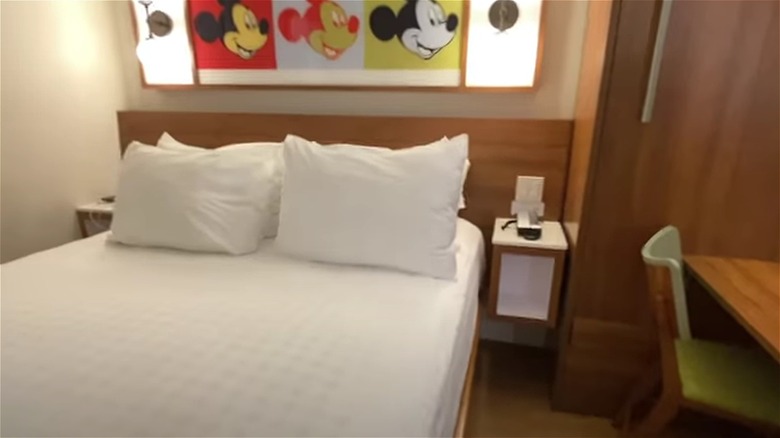
Autistic Interpretations/YouTube
For individuals with unique sensory needs, transitions can be difficult. My teenage son no longer requires a visual schedule for big changes. But having a breakdown of what to expect and plenty of time to mentally and physically prepare, and process transitions, can completely change the value of his experiences. And honestly, who wouldn’t benefit from more time and space between shifts in their schedule — particularly when traveling?
Taylor Heaton of Mom on the Spectrum understands the importance of taking space for transitions better than most, as a late-diagnosed autistic adult and mother of two young autistic children. In her post-vacation Disney guide, Taylor emphasized the importance of setting up a home base at your resort first before doing anything else on your trip. While it’s easy to get caught up in the vacation excitement, taking some time out to adjust can help get your trip started on the right foot and create a safer climate for your overall experience. “Spend a little bit of down time there and get acclimated to your surroundings,” Heaton suggested.
It’s also a good time to make sure they know where to find everything they need and can identify the room number. She continued, “Let them experience all the new things, and help them talk through what they might be seeing and feeling for the first time now that you’ve arrived.” And don’t forget to power up with snacks and hydration before setting out on the next phase of your adventure.
Prioritize snacks and hydration

Oksana Klymenko/Shutterstock
Keeping everyone in your party energized with healthy fuel and proper hydration will go a long way in terms of vacation stamina and comfort. Even if you’re pretty good about pacing yourselves, a Disney vacation can be something of a marathon. Hungry bellies can bring down the vibe and lead to some serious discomfort. While it’s true that Disney fast food is some of the best you’ll ever have the pleasure of trying, there’s only so much greasy junk food and carbs a person can take before feeling bogged down. Some folks with special sensory needs are also prone to GI issues and abdominal pain, both of which can tank your fun. And some neurospicy guests would simply prefer to eat what they’re already familiar with, which can make grabbing food on the go something of a hassle.
The good news is that Disney understands not everyone can live on Dole Whips and candied bacon for days at a time. That’s why the parks allow guests to bring in their own food and drinks “provided they are not in glass containers, do not require heating, reheating, processing or refrigeration and do not have pungent odors” (via Disneyland’s FAQ). The parks even feature designated areas for guests to sit down and chill out while they enjoy said snacks. Take advantage of this by filling up your bag with healthy snacks and stashing a couple of well-insulated thermoses to use at the parks’ water refill stations.
Watch YouTube videos of Disney experiences beforehand
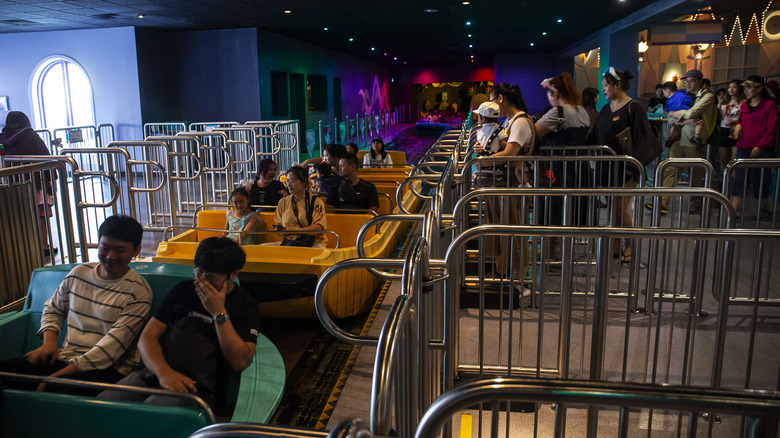
Bloomberg/Getty Images
Knowing exactly what to expect ahead of a Disney vacation can go a long way in reassuring folks when they’re feeling uncertain about being exposed to a steady stream of new things while they’re far away from familiar surroundings. And stepping onto a ride where who knows what could be lurking around the next corner could be absolutely frightening to some sensitive individuals regardless of age or cognitive ability.
The beauty of living in the digital age is that we have a way to virtually ride everything Disney has to offer right from our living rooms anytime we want. Before we took our kids to Walt Disney World, I made sure everyone knew exactly what to expect on the rides we’d find there by sharing POV ride videos. They’ll get to hear ride sounds and see how long each ride lasts. TPMvids is a fantastic source for high-quality POV Disney park ride videos.
Not only did watching videos give my kids a preview of what we would experience on those rides, but it also helped us to determine if an attraction wasn’t a good fit for our child’s sensory needs. The last thing I’d want to do is persuade my children to ride something they’re not comfortable with and then watch them suffer through a bad time. It’s also a great way to get them excited about the trip. And the best part? You can relive your vacation anytime once it’s over!
Consider getting a wheelchair at DAS
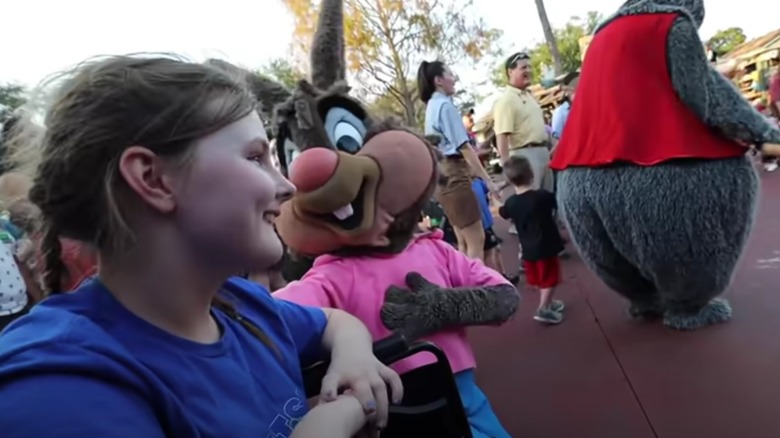
FatheringAutism/YouTube
Even if you or your sensitive party member does not typically use a wheelchair or stroller, it might be worthwhile to pick one up while you’re at Disney. According to the Mayo Clinic, the average American logs fewer than 4,000 steps in a given day. When Disney experts Ears of Experience checked their steps on a couple of Disney trips, they packed in a whopping 19,361 steps one day during a trip to Disneyland — that’s nearly 9.5 miles! And on their visit to Walt Disney World in Florida, they managed to get in more than 20,000 steps, or 10 miles. If a member of your party has sensory issues, that’s just one more thing to add to their discomfort.
When Asa Maass of Fathering Autism noticed his autistic daughter Abigail was having a rough time at Disney, a wheelchair turned out to be just what the doctor ordered. “We stopped in guest services and got a wheelchair ’cause Abigail was wanting to sit down on the ground everywhere,” Maass explained. While she wasn’t initially interested in it, the chair turned out to be a welcome change later on in the day. For families with children who are young enough to ride in a stroller, getting it tagged as a wheelchair through Guest Services will allow you take it into more locations at the park.
Talk about what to expect throughout your trip

Shapecharge/Getty Images
While you’re at your hotel or resort, don’t underestimate the value of talking about what to expect as you transition throughout the day. Aside from what you’ll experience inside of attractions, Disney parks offer a range of experiences, and understanding what is coming up next can mean the difference between a good experience and a bad one. Taylor Heaton of Mom on the Spectrum walked her family through what to expect every step of the way. She explained, “Once we got to the resort, there’s that travel channel that just plays 24/7.” Watching these videos about the parks during their hotel downtime helped Heaton’s kids to know what types of things they’d be seeing as they transitioned from one location to another between their hotel and the parks.
Heaton also broke down what they’d be doing for the day every morning so that the kids were ready for their next big adventure at every juncture. “We’re going to get dressed. We’re going to brush our teeth. We’re going to put sunscreen on outside. We’re going to sit in the stroller and push it over to the bus stop,” she expanded. This is also a good time to break out any visual schedule or schedules you might have prepared ahead of time. And don’t forget to keep checking in throughout the day.
Research your dining options beforehand
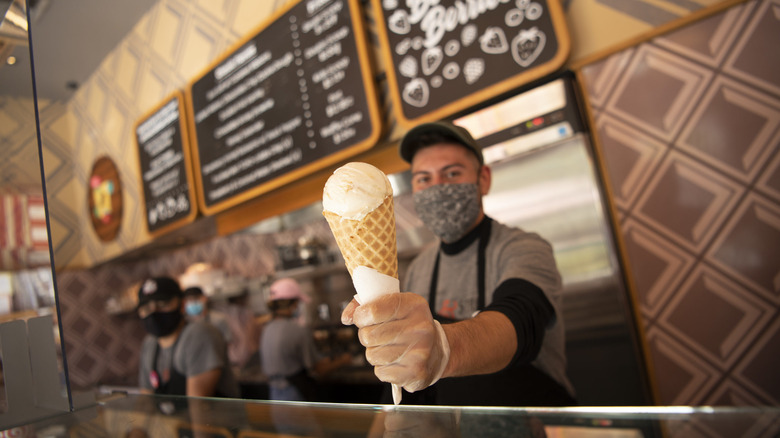
Handout/Getty Images
Even if you’ve got plenty of snacks in your bag, you’ll almost invariably need to eat park food at some point during your Disney vacation. And with sensitivity issues in the mix, it’s a good idea to lay out the options ahead of time so that there are no unwanted surprises that could put a wrench in your plans.
One of the great things about dining at Disney is that it’s so easy to look up what’s available ahead of time. And unlike some other, less magical theme parks, Disney has a wide range of culinary options available to choose from — many of which are recipes unique to an individual kiosk or park. You can even arrange your food ahead of time by scheduling Disney dining in advance. But the reality is that our stomachs don’t always cooperate with schedules, particularly if there’s someone in your party with special sensory or cognitive needs. When you’re feeling particularly hangry after park-hopping all day, waiting to eat at a pre-scheduled time isn’t always the best idea.
A better option when this happens is to hop on the My Disney Experience app and order your food from one of the park’s quick dining options. You can even use the app to arrange for special dietary needs, including allergy-safe and gluten-free options.
Bring tablets, screens, and portable chargers
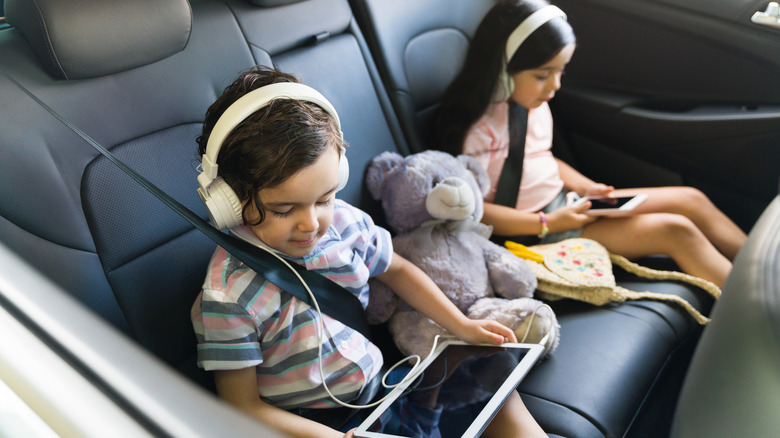
antoniodiaz/Shutterstock
Whether you’re an adult with special sensory needs or you’ve got kids in your party, sometimes having a screen in front of you can be absolutely transformative when everything starts to be too much. I never make assumptions about anyone — child or adult — who is staring at their phone or tablet screen, since screen time can be a tremendously beneficial tool for individuals with sensory processing disorders, anxiety, and a whole host of other neurodiversity issues. Having a way to mentally step out of a situation when things get to be overwhelming can quite literally make it possible for some folks to stay in spaces they otherwise might not be able to, providing calming relief and a source of support. That is also why it is so important to make sure you’ve got yours if you need them.
Even if you don’t end up using them because you’re so busy getting your magic on, having that tablet available just in case you need it can be reassuring. Phones or other electronic devices can also help you navigate the park, check ride times, and make any necessary online arrangements through the My Disney Experience app. Just don’t forget to bring an extra power bank and a cable or two so that you don’t get stuck at 2%.
Look for the blue umbrellas
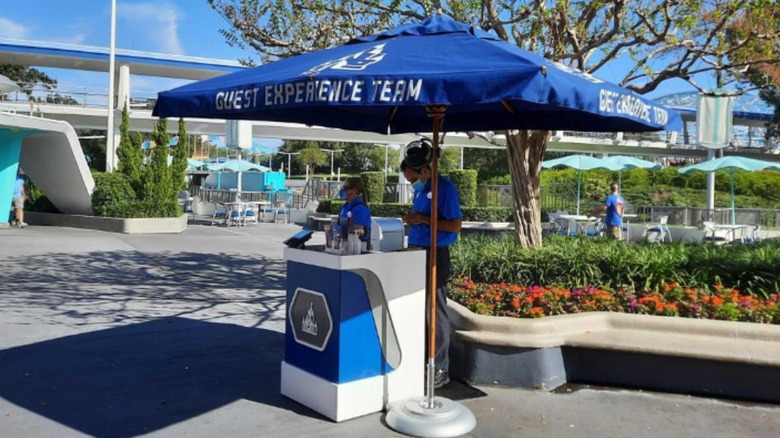
Melissa Bednar Travel/Facebook
Guest Experience kiosks can be found throughout the parks and are typically identifiable by blue umbrellas and cast members’ blue shirts. These fine folks can help you out with all sorts of information, including general park info, assistance navigating the My Disney Experience app, wait times, and lost and found items. They can also help you out with recommendations.
Knowing who to contact when you need help at Walt Disney World can take a lot of the stress off your shoulders. And it’s a good idea to make sure everyone in your party knows where to go for help if they get lost or need something. This is especially true for the younger members of your group or anyone who needs extra assistance. That way, if you end up getting separated, they’ll know who to look for. Show everyone in your party what the blue umbrellas and shirts look like and make sure they understand this is where they need to go if they get lost or separated. It’s also a good idea to go over what Disney cast members’ name badges look like since many cast members will be dressed in uniforms unique to a specific location.
Take breaks
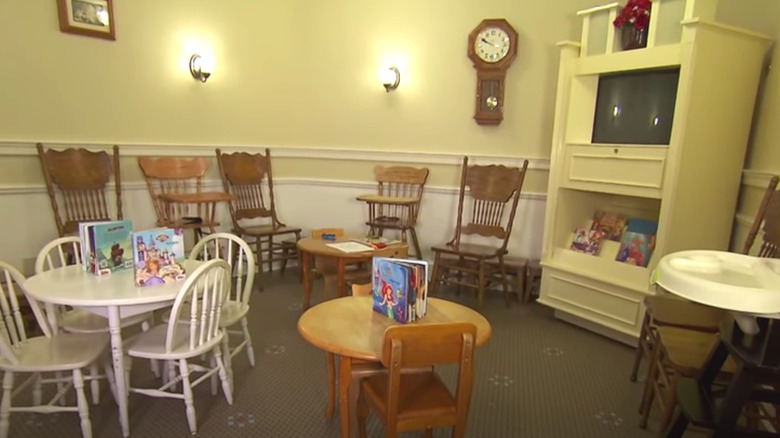
Disney Parks/YouTube
By far, one of the most useful things our family found for getting through a day at Disney was a secret spot for a sensory detox. Before we traveled to Disney World with three young children in tow, I naively had it in my head that if our autistic son became overwhelmed, we could just skip back to our resort for a couple of hours and decompress. Even though I’d been to Disney World many times in the past, I hadn’t really figured in the reality of waiting for buses to transport us back to the hotel and all of the many disruptions and transitions that would involve. In reality, this just wasn’t a realistic or reasonable option for us.
But I had read that the Magic Kingdom’s Baby Care Center was not just for babies, so when our little guy started seriously stimming, we headed there. Inside was a nearly empty space with low tables for the kids and dimmed lighting, a welcome respite from the blazing sun outside. And there, in the middle of a chaotic day with my three kids on the verge of a full-scale meltdown, we watched “Wall-E” in its entirety.
By the time it was over, everyone was rested, refueled, and ready to get back out there — a Disney miracle. A complete guide to sensory break zones can be found in the Walt Disney World cognitive guide book. If you’re traveling to another Disney park, a cast member can recommend calm spots.

